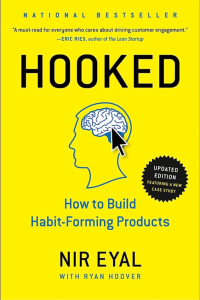For solopreneurs navigating the digital marketing space, creating a product that stands out in the saturated online market is only half the battle; the real challenge lies in making that product indispensable to the user. "Hooked: How to Build Habit-Forming Products" by Nir Eyal is not just a guide; it's a deep dive into the user's mind. It's about understanding the 'why' behind user habits and leveraging that knowledge to build products that users don't just use, but rely on.

"Hooked" provides a framework, the Hook Model, a four-step process embedded into the products of many successful companies to subtly encourage customer behavior. Through consecutive cycles of the Hook Model, successful products reach their ultimate goal of unprompted user engagement, bringing users back repeatedly, without depending on costly advertising or aggressive messaging. The Hook Model consists of:
- Trigger: What internal or external cue prompts the user to take action? Understanding this leads to effective product cues that drive user engagement.
- Action: What simple action is done in anticipation of a reward? This insight helps in streamlining user activities for maximum product enjoyment and engagement.
- Variable Reward: How are users gratified for their action? Here, the psychology of variable rewards is introduced to create a sense of "wanting" in the user's mind.
- Investment: What further action does the user take to increase the likelihood of returning? This section elaborates on the user investments that solidify the habit.
For solopreneurs, "Hooked" is particularly enlightening because it goes beyond the conventional tactics of marketing and enters the realm of product development and user experience, areas that significantly influence customer retention and word-of-mouth referrals. Eyal's insights encourage you to think from the user's perspective, which is crucial when you're competing against larger companies with more resources.
However, it's important to note that while "Hooked" provides a robust framework for understanding user behavior and building habit-forming products, it doesn't offer a one-size-fits-all solution. The applicability of the Hook Model can vary based on the nature of your product or service. Moreover, the book primarily focuses on product development and user psychology, with less emphasis on other areas of digital marketing like SEO, content strategy, or social media outreach.
In conclusion, "Hooked: How to Build Habit-Forming Products" is an essential read for solopreneurs in the internet marketing arena. It shifts your focus from just acquiring users to actively engaging them, creating a product so well-integrated into their routines that it becomes indispensable. In a market where consumer attention is the ultimate currency, "Hooked" helps you design products that not just capture attention, but hold onto it. It's not about creating a product that people use, but creating one they can't do without.
ChatGPT Prompts:
"Hooked: How to Build Habit-Forming Products" by Nir Eyal explores the psychology behind what makes people engage with certain products out of habit and how businesses can design their products to encourage such behavior. Here are some specific prompts for this book:
Understanding the Concepts:
- "Can you summarize the 'Hook Model' that Nir Eyal discusses in 'Hooked,' and how it's used to encourage customer engagement?"
- "How does 'Hooked' define 'habit-forming products,' and what distinguishes them from regular products?"
Application of Principles:
- "How can a mobile app startup apply the principles from 'Hooked' to ensure high user engagement and retention?"
- "Considering the ethical implications, how should companies balance creating habit-forming products with ensuring they're not leading to addictive behaviors?"
Comparison with Other Strategies:
- "How do the strategies for creating habit-forming products in 'Hooked' align or conflict with traditional marketing strategies focused on one-time sales?"
- "Can you compare the 'Hook Model' with other popular product design or customer engagement strategies?"
Exploring Specific Concepts:
- "What role does 'variable rewards' play in the 'Hook Model,' and why is it crucial for creating habit-forming products?"
- "How does the 'investment phase' of the 'Hook Model' contribute to user retention and engagement?"
Critiques and Limitations:
- "What are some criticisms of the habit-forming strategies presented in 'Hooked,' particularly concerning consumer well-being?"
- "Are there industries or product types for which the 'Hook Model' is less applicable or effective?"
Expansion Ideas:
- "Beyond product design, how can the principles of building habit-forming behaviors be applied in areas like lifestyle change or learning?"
- "Can the 'Hook Model' be effectively used to encourage positive societal habits, like recycling or community involvement?"
Real-world Examples:
- "Can you identify a product or app that successfully employs the strategies from 'Hooked' and analyze how it does so?"
- "What's an example of a product that failed to become habit-forming despite high initial engagement, and how might it have fared using the 'Hook Model'?"
Reflection and Personal Application:
- "How has your perspective on daily product interactions changed after reading 'Hooked'?"
- "What principles from 'Hooked' do you believe are most applicable to your current projects or entrepreneurial aspirations?"
By harnessing the Power of Few-Shot and Multi-Shot Learning in Conversational AI, these prompts are designed to encourage critical thinking and application of the concepts in "Hooked" across various contexts and industries.
